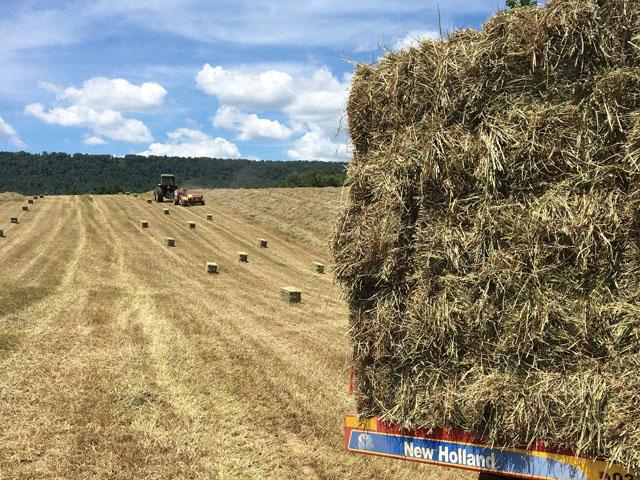Ag Policy Blog
USDA Opens Up Emergency CRP Haying and Grazing for Wildfire Recovery
To help livestock producers recovering from wildfires, USDA has announced the release of emergency haying and grazing on Conservation Reserve Program acres nationwide.
The announcement is meant to help livestock producers in Nebraska, Oklahoma and Texas who were hit by the wildfires at the beginning of March.
"Many ranchers in Nebraska, Texas and Oklahoma impacted by the recent, devastating wildfires are in need of grazing acres and hay resources to sustain their herds while they work over the coming months to restore their operations," said Kelly Adkins, state executive director for USDA Farm Service Agency (FSA) in Texas. "If you have CRP acres and want to help wildfire-impacted ranchers, please contact your local FSA office. We'll determine available emergency and non-emergency use options. Your assistance is needed and greatly appreciated."
The states and counties affected by the wildfires include:
-Nebraska: Custer, Lincoln and Logan
-Oklahoma: Beaver, Dewey, Ellis, Harper, Kay, Roger Mills, Texas, Woods and Woodward
-Texas: Armstrong, Carson, Gray, Hartley, Hemphill, Hutchinson, Lipscomb, Moore, Ochiltree, Oldham, Potter, Roberts and Wheeler
PRIMARY NESTING SEASON RULES
A complication in Texas, however, is that emergency haying and grazing is only available until the beginning of the primary nesting season in each state. For Texas, the nesting season goes from March 1 until July 1. Still, producers can continues to donate emergency grazing authority to livestock producers in counties that qualify for the Livestock Forage County due to drought.
FSA notes, "Emergency grazing can continue during the primary nesting season with a 50% reduction in stocking rate if the county meets the Livestock Forage Program drought eligibility trigger of D2 for eight consecutive weeks or D3 or greater on the U.S. Drought Monitor."
P[L1] D[0x0] M[300x250] OOP[F] ADUNIT[] T[]
Along with Teas, primary nesting season has already begun in New Mexico and Colorado.
In Kansas, primary nesting season begins April 15. For Oklahoma, Nebraska and Missouri, the primary nesting season begins May 1.
For full details on emergency haying and grazing options, check with your local USDA Farm Service Agency office.
HOW TO DONATE CRP GRAZING AND HAYING RIGHTS
Eligible CRP participants who want to donate CRP acres for the purpose of emergency grazing and haying must obtain a modified conservation plan, which includes emergency grazing requirements from either USDA's Natural Resources Conservation Service (NRCS) or the participant's Technical Service Provider before the CRP acres are hayed or grazed. To ensure emergency haying or grazing of CRP acres is only being utilized by livestock producers adversely impacted by the wildfire, the livestock producer must file a CCC-576 (Notice of Loss) or provide a written certification to be included in the CRP contract file.
Haying or grazing activities are not authorized if these activities will cause long-term damage to the vegetative cover on the land as determined on a contract-by-contract basis. The CRP participant is responsible for non-compliance with the CRP contract provisions.
Due to privacy laws, FSA cannot release the names of producers willing to assist livestock producers in the fire-impact areas without their written consent. CRP participants must voluntarily disclose their willingness to assist livestock producers and consent to the disclosure of their personal information before FSA can release the information to livestock producers seeking assistance.
CRP participants who are interested in donating CRP grazing and haying privileges should contact their local USDA Service Center to confirm CRP practice eligibility and obtain approval from FSA prior to grazing or haying eligible CRP acres.
There also are options for non-emergency haying and grazing of CRP acres as well. Non-emergency grazing and haying activities can occur according to the CRP participant's conservation plan during drought or natural disaster conditions, but the site conditions should be taken into consideration and the plan modified, as needed. Non-emergency harvesting for hay is authorized once during the approved event and no later than Aug. 31. Participants must leave 25% of the contract acres unharvested or hayed. Non-emergency grazing must not exceed 120 days. During the PNS, there must be a 50% carrying capacity reduction. For both non-emergency grazing and haying, there will be a 25% annual rental payment reduction.
More details on disaster aid for wildfire recovery can be found at www.farmers.gov
More details on emergency haying and grazing, along with maps for the primary nesting season can be found at https://www.fsa.usda.gov/…
Also see, "Wildfire Risk Contained but Ongoing Caution Needed for Livestock," https://www.dtnpf.com/…
Chris Clayton can be reached at Chris.Clayton@dtn.com
Follow him on X, formerly known as Twitter, @ChrisClaytonDTN
(c) Copyright 2024 DTN, LLC. All rights reserved.






Comments
To comment, please Log In or Join our Community .